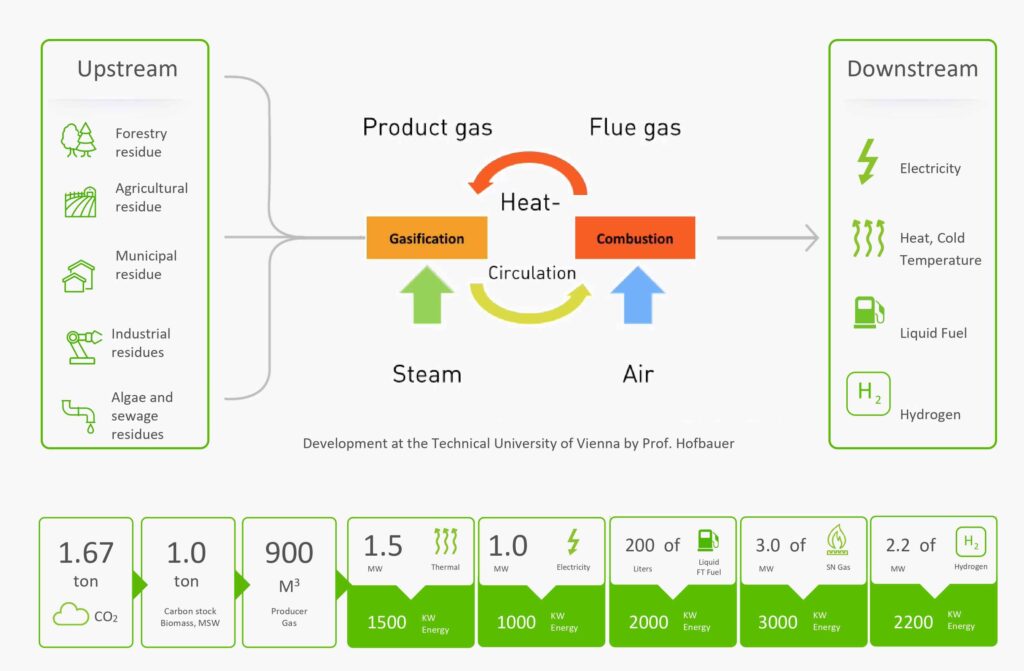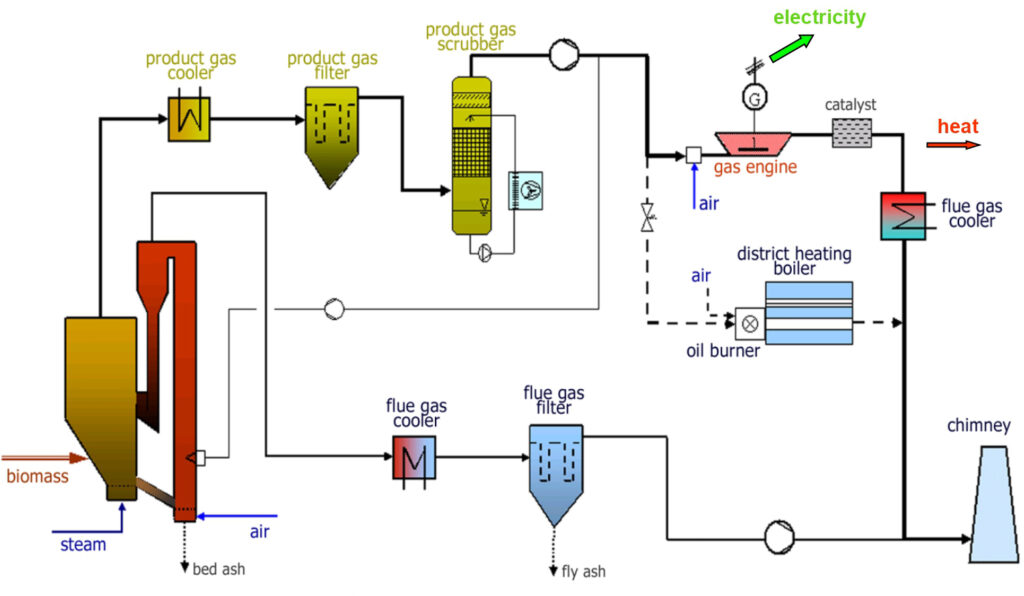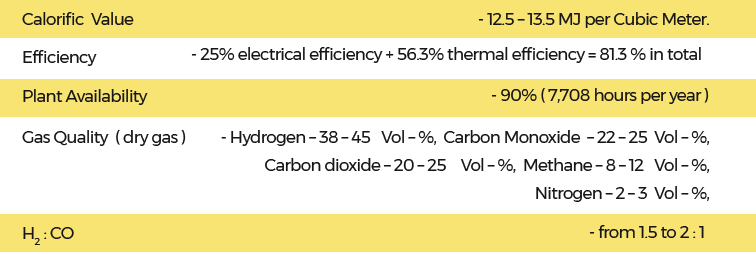
The Dual Fluidized bed (DFB) Steam Gasification process is considered as one of the most sophisticated processes in the world. It can convert 1 Ton of biomass or garbage (RDF) to –
- either 1 MWh electricity plus 2.5 MWh thermal energy
- or 2 MWh liquid fuel plus 1.5 MWh thermal energy
- or 2.5 MWh synthetic natural gas plus 0.4 MWh thermal energy
- or 2 MWh Hydrogen plus 1 MWh thermal energy
Process

In the process, biomass is fed into the fluidized bed reactor through a rotary valve and a screw feeder. The FICFB (Fast Internal Circulating Fluidized Bed) Gasifier consists of two interconnecting zones – a gasification zone and a combustion zone. The gasification zone is fluidized with steam, which is generated from the waste heat of the process to produce a nitrogen free producer gas. The combustion zone is fluidized with air and delivers the heat for the gasification process via circulating bed material through a syphon. Here, combustion takes place of non-gasified carbon, which is transported from the gasification zone into the combustion zone. Product gas is used as an additional fuel to control the process temperatures. The heat required for the endothermic steam gasification reactions is transported by the bed material from the exothermic combustion chamber into the endothermic gasification chamber. This is how a nitrogen-free syn gas can be produced.

The resulting raw producer gas is cooled and cleaned by two stage cleaning system. Tar, dust, condensate etc. are removed by an oil scrubber. Scrubber liquid saturated with tar and condensate is vaporized and introduced into combustion zone of the gasifier. Waste heat is available during cooling of the syngas, which is effectively used for drying of the feedstock or any other application. Only dry ash with very low carbon comes out from the system and there is no liquid effluent.

Advantages
- The system is meant for decentralized on-site generation of energy, wherever biomass available.
- Syngas from DFB Gasifier contains almost zero Nitrogen (2-3%) and very high percentage of Hydrogen (35-45%).
- It is a multi-fuel system – capable of accepting a wide range of biomass as feedstock.
- Syn gas has 3.5 to 4 times higher Calorific value (3,500 – 4,000 Kcal per Kg) compared to the same from any conventional gasifier. H2 : CO = 1.5 ~ 2 : 1.
- Because of the above reason, even after extraction of H2, the tail gas is good enough to run a gas genset for generation of electricity.
- It is a self-sustainable technology, does not require any external auxiliary power or energy.
- It is a zero liquid discharge plant and requires no Effluent Treatment Plant.
- O2 deprived atmosphere at low temperature in gasifier doesn’t allow formation of Dioxins and Furans from MSW gasification. Similarly, large molecules of plastic are completely broken down to components of syngas restricting production of toxic gases with SOx and NOx.
Fuel Tested
- Forest Products
Soft wood Pellets, Recycling Wood, Waste Wood, Wood Chips, Bark
- Bio-renewable Waste
Sewage Sludge Pellets, Tree and Shrub Clippings, Palm Fonds
- Energy Crops Waste
Reed Grass
- Food Crops Waste
Empty Fruit Bunches, Wheat Bran, Exhausted, Olive Pomace, Rice Husk
- Sugar Crops Waste
Sugar Cane Bagasse, Sugar Cane Residue
- Other
Shredded Light Fraction ( SLF, Automotive Plastics ), Lignite
- Fuel Mixture
50% tree and shrub clippings – 50% softwood pallets, 50% leaves – 50% softwood pallets , 40% straw – 60% softwood pallets, 50% Municipal solid waste (MSW) – 50% softwood pallets, 50% SLF – 50% softwood pallets, 20% PE – 80% PET, 40% PE – 60% PS, 75% MSW – 25% Lignite
